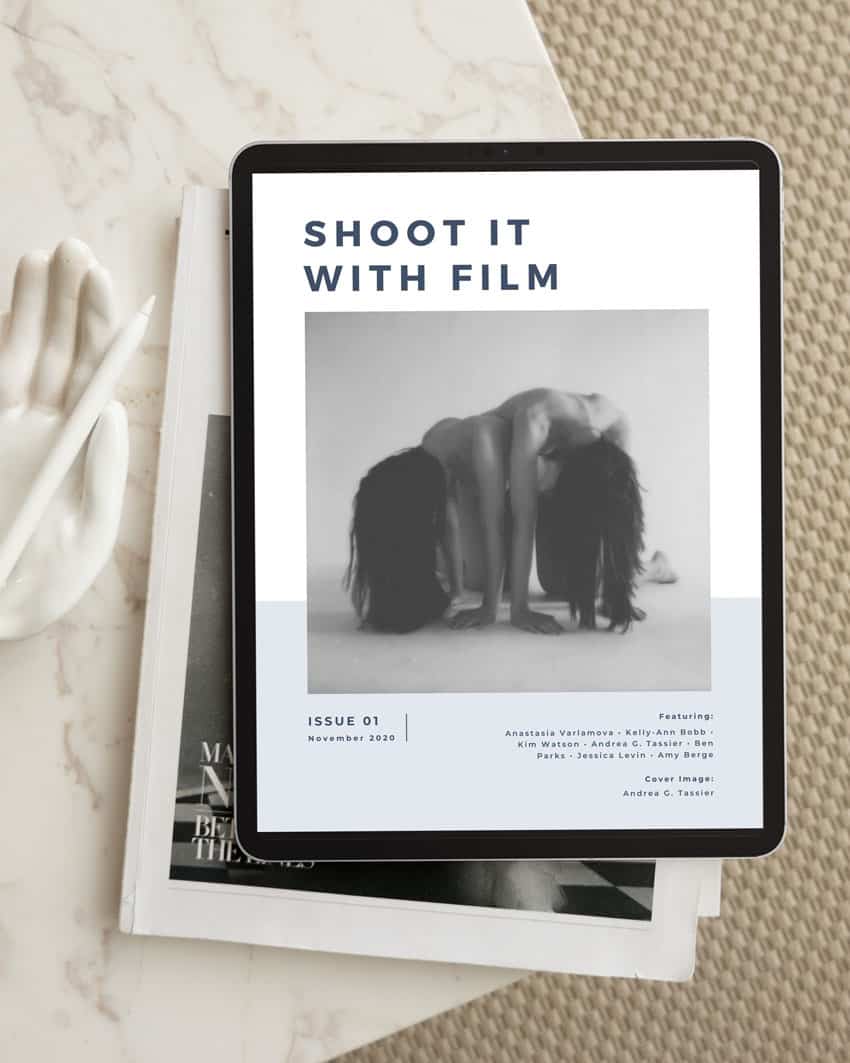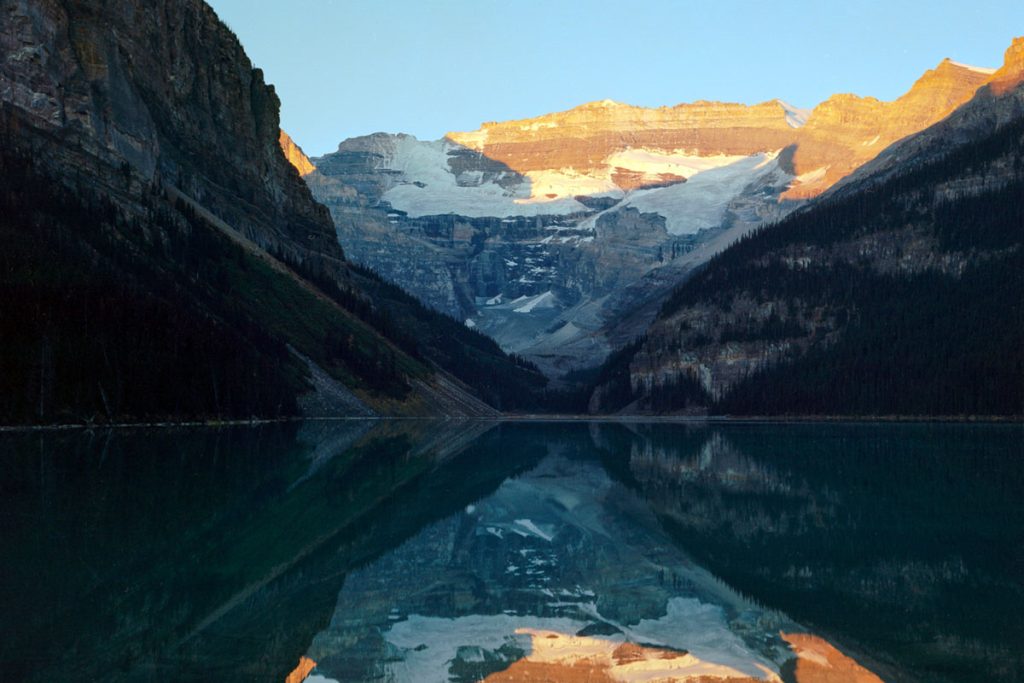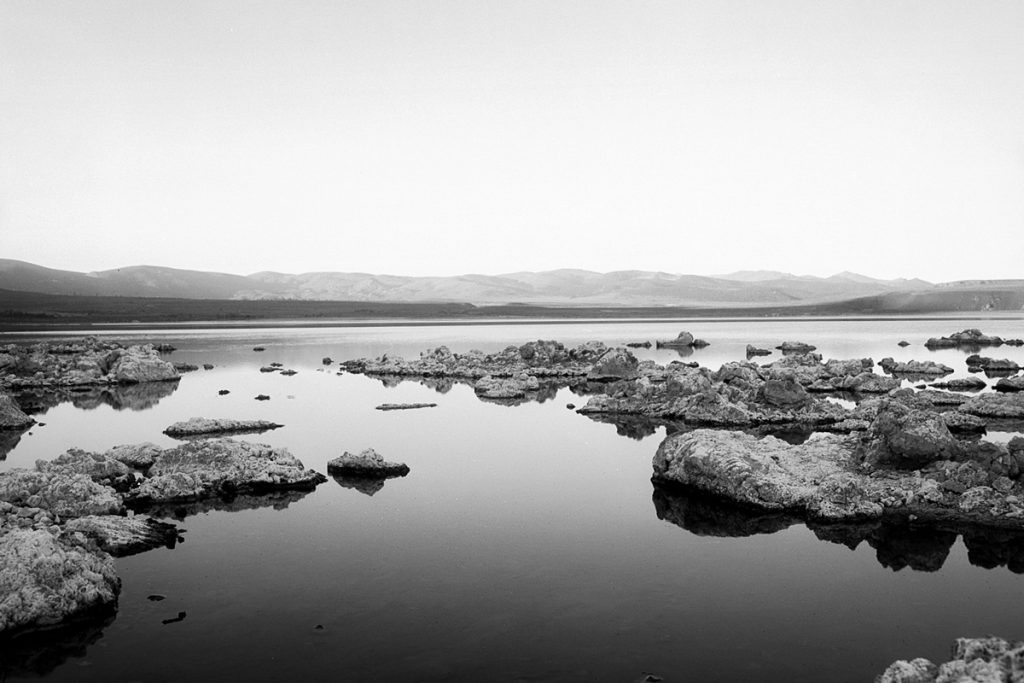
Written by Taylor Blanchard
How long once you have a camera until you start plotting for your next?
I was enamored with my first 4×5 camera, a folding Anba Ikeda field camera, until I wasn’t. The Anba is lightweight and a smooth cherry wood, but it had small brass knobs that came off way too easily. Several times I was shooting in the field (even a literal field) when a knob would come off, and I had to search on the ground for a very small piece of brass.
It offered limited movements, only a front rise and tilt. The ground glass was dim, and I considered adding a Fresnel, which would make the image on the ground glass brighter, so it’s easier to focus and compose your image. But, I never added a Fresnel and, instead, started thinking about another 4×5.
After doing a bit of research and looking at my budget, I landed on the Intrepid 4×5 MK5. I chose the limited black edition (at $405, it was a bit more expensive than the natural wood) and added the Fresnel screen (at $34 extra). I bought it directly from Intrepid, and it shipped to me in a few weeks.
Find the Intrepid 4×5 MK5 at B&H Photo or at intrepidcamera.co.uk.

History of Intrepid Camera
Intrepid is a UK-based company that was founded in 2014 with the goal of making a new large format camera that was affordably priced. Most of the large format cameras available at the time were many decades old and getting expensive on the second-hand market. A few new large format cameras were available, but at a steep price tag.
After their first test models, Intrepid launched a Kickstarter campaign for their first 4×5. They construct their cameras from wood, aluminum, and 3D printed components and assemble them by hand. They also make the ground glass by hand.
Over the years, Intrepid has continued to iterate and improve their designs. In addition to the 4×5, they also make 5×7 and 8×10 cameras, a darkroom enlarger (which can convert your 4×5 camera into an enlarger), and several accessories. They have also developed a lens, shutter, and electronic remote, which is currently in a Kickstarter campaign.



The Feel and Size of the Intrepid 4×5 Camera
Out of the box, the Intrepid MK5 is very lightweight, weighing 2.8 lbs/1.3 kg. It’s small when it’s folded down, at 7”x7”x3.8”, or 180x180x97mm.
The size and weight makes it easy to carry when I’m hiking or traveling. I can fit the camera, lenses, tripod, several other cameras, and film in a moderately sized backpack. (Often my “personal item” I bring on an airplane is all cameras and film!)
The black edition uses 3D printed material for the front and rear elements. The standard camera uses manufactured, pressed plywood, which is treated to hold up to the elements. Neither Intrepid has the look and feel of cherry or other fine woods often used in large format cameras, but Intrepid materials are sturdy and lightweight.

Features of the MK5
You immediately notice the four bubble levels on the Intrepid 4×5 camera – two on the front standard and two on the rear standard – an incredibly helpful feature when composing a photo. On my previous camera, I used the bubble on my tripod when setting up the camera, but if I needed to move the tripod or adjust the camera position, it was a bit of a guessing game if the camera was level.
The rear standard rotates very easily from landscape to portrait, using an ingenious design of magnets to quickly snap into place. This makes switching between landscape and portrait orientation a quick process. My Anba had clips that you would remove to pull the back entirely off, rotate, and then secure in the new position.
The Intrepid has a universal Graflok back, which means you can use any Graflok back, such as the LomoGraflok Instant back by Lomography for shooting Instax Wide film.
The camera uses Linhof/Technika-style lens boards, which are the most common, and supports lenses from 75 to 300mm. (Remember that a 150mm lens on a 4×5 is equivalent to 50mm on a 35mm camera). If you have a 75mm lens, you will need a recessed lens board.
A fun option with Intrepid cameras is to customize your bellows in black, blue, green, and red – or a limited-edition teal or yellow.
In previous designs of the camera, you could not remove the bellows; you can with the MKV. The bellows are waterproof vinyl and quite sturdy. The bellows also fold up quite neatly when you pack your camera – again, another improvement they’ve made. Both of those factors help its resistance to tearing or holes.
Intrepid previously said they are making bag bellows for lenses longer than 300mm, but I haven’t seen an update.


Using the Intrepid 4×5
Before my first outing with the Intrepid, I secured my Peak tripod plate to the camera. One of the improvements that Intrepid made over its camera iterations was to upgrade the tripod plate to aluminum. Once the tripod plate is in place and the camera is mounted to the tripod, the camera opens easily.
Once the camera is open, you must secure the front standard to the base in one of four provided holes with a screw. Apparently, this is an area where Intrepid improved on the design; in previous generations, the pin wasn’t always long enough and the washer was prone to coming off.
Intrepid also provides zeroing guides, so you can ensure the front standard is aligned and straight.
However, this feature is at the heart of my most significant criticism of this camera. You choose which of the four holes to use based on the focal length of your lens, but your distance to the subject also plays a part. So, you may have to unscrew and re-screw the front standard in the field. I also find it to be the most time-consuming part. With my Anba, I only had to turn the knobs on the side of the camera to move the front standard forwards or backwards.
Setting the lens is straightforward and easy. I had to adjust the sliding clip with an Allen wrench so my lens board would fit without falling out, but it was simple to do.
After your lens is in place, you can use the bubble levels to adjust the position of your camera. Then it’s time to stop down your lens, open the shutter, and examine the scene on the ground glass. I love the bright screen with the Fresnel.
With large format photography, you usually need a dark cloth to cover your head and the back of the camera to block out the light so you can see the scene on the glass. On the Intrepid, the glass is so bright that I often don’t need to use a black cloth. The ground glass includes a very helpful grid in ½” increments.
Once your scene is composed, the front standard has an inner control for rise/fall and an outer control for tilt. You can adjust the front standard for swing, and the back standard can be adjusted for tilt also.



Resources Available
One of the benefits of buying a new camera from an operating company is the ability to have dedicated user support. While Intrepid does not provide a very detailed guide with the camera, they have created many videos about the operation of the camera and general information about shooting large format. I’ve found their chat and email support responsive and helpful. If you are new to 4×5 photography though, you’ll probably find yourself looking at other videos and resources.
I recommend picking up The View Camera by Harvey Shaman and Using the View Camera by Steve Simmons. Mat Marrash’s videos on YouTube, Large Format Friday, are also extremely helpful.
Because I had already purchased everything needed for a 4×5, getting started with the Intrepid was a breeze. Of course, if you’re new to 4×5, you’ll need to buy film holders, a lens and a lens board, and film. Then you will also want to add a dark cloth, loupe for focusing, and a cable release.



Conclusion
If you’re interested in getting into large format photography or if you currently shoot something like a Graflex Crown Graphic and want more movements, the Intrepid 4×5 MK5 is an excellent camera at a reasonable price. I’ve seen criticisms of them over the years, but they continue to listen to user feedback and improve.
Other than the gripe I have with the front standard, the camera is a delight to use. The bubble levels, the bright Fresnel, and the rotating back are lovely. Is it perfect? No. And yes, I already have my next large format camera picked out, a much pricier Chamonix…
Do you have an Intrepid or do you have any questions about the MK5 4×5?


Thank you so much, Taylor! Taylor is a regular contributor here at Shoot It With Film, and you can check out her other articles here, such as Top 4 Darkroom Safety Tips and 7 Lesser-known Color Film Stocks Worth Trying.
You can also check out more of Taylor’s work on Instagram.
Leave your questions about the Intrepid 4×5 MK5 large format camera below in the comments, and you can pick up one for yourself at B&H Photo or at intrepidcamera.co.uk.








Blog Comments
Paul
November 1, 2024 at 1:51 pm
Thank you for your comprehensive review. Back in the pre-digital era, I photographed architecture and interior design with a monorail 4×5. I stopped doing that about 30 years ago, and have mostly worked with 35mm and 120 since then. Lately — probably it’s an old guy’s nostalgia — I’ve wanted to work with large-format, and the Intrepid has tempted me. I’m weighing the pros and cons that you mentioned.
Taylor Blanchard
November 2, 2024 at 12:56 pm
Paul – thank you for the comment! Yes the Intrepid is certainly has a lot of appealing qualities. I’m wondering if you would miss some of the movements compared to a monorail? Hopefully you kept some of your lenses. Either way, it sounds like you’re so close to taking the plunge. Do report back if you get back into 4×5.
Jens Rueckert
November 1, 2024 at 7:28 pm
Hi and thank you for writing and sharing this article.
I started to shoot 4×5 this year as I found a quite reasonably priced Linhof Technika. At the same time I also got the offer for an Intrepid 4×5, black edition. Now I kind of suddenly became the owner of two different large format cameras with different pros and cons whereas the main points are the weight vs sturdiness. I like them both. The look of the wooden Intrepid cameras is more aesthetic imho, whereas the metal made Linhof as well as the Intrepid that is made of 3d printed parts and anodised aluminium are more to my liking as they seem more weather resistant to me.
And here as well is the only flaw in the above article: the black Intrepid has not wooden but is (quote:) “only made from high quality 3D-printed parts and anodised aluminium.”
So it is a great camera to take for a longer walk if you do not need the sturdiness of the Linhof…
Always good light!
Regards
Jens
Taylor Blanchard
November 4, 2024 at 3:22 pm
Hi Jens – on my gosh, yes, you’re correct that the black edition is 3D printed and the other Intrepids are pressed wood. I’ve updated the article to reflect that. I really appreciate it!
Jens Rueckert
November 1, 2024 at 7:35 pm
Hi and thank you for your article and nice review.
The Intrepid camera is a wonderful lightweight camera, easy to carry and to use.
I use a Linhof 4×5 and got the Intrepid a few weeks ago, and both of them have their advantages, one is sturdier the other lighter and easier to transport.
Anyway: the only flaw in your article is that “the Intrepid is made from high quality 3D-printed parts and anodised aluminium”. That’s why I decided to use the black version instead of the wooden ones as I like to shoot in harsher and sometimes rainy conditions.
All the best and always good light.
Regards,
Jens
Ray
November 1, 2024 at 9:37 pm
Taylor, A good review of this 4×5. I’m fortunate to have a Chamonix 045-N2 so I’m not tempted to think of getting an Intrepid, however I’ve been to their website and find they are making it easier for new 4×5 users to enter the marvellous realm of LF. Top marks to them for that. Once you own a 4×5, the next hurdles are lenses and film! Many photos can be taken with a single lens but, if you’re like me, I got more lenses. It can be expensive but LF teaches more about photography than you will get from digital and you learn to use LF films judiciously and with a far more measured approach. Reduce cost by doing your own D&P.
Taylor Blanchard
November 2, 2024 at 1:00 pm
Hi Ray – thank you, and I agree it’s great that Intrepid is building enthusiasm for LF. Right now, I only have a 150mm lens Nikon Nikkor f5.6 but I think something in the 90mm and 210mm range is next on my list. I’ve read a lot of articles – any lenses that you would recommend?
Mark Lloyd
April 25, 2025 at 12:56 pm
I also have an Ikeda Anba which I love for it’s light weight and it’s exquisite craftsmanship, but The little knobs that I was afraid of losing and origami like folding was always frustrating. After reading this I just ordered an Intrepid.
Taylor Blanchard
May 2, 2025 at 6:00 am
Mark – thank you for the comment! please report back after you’ve received the Intrepid and let me know what you think.